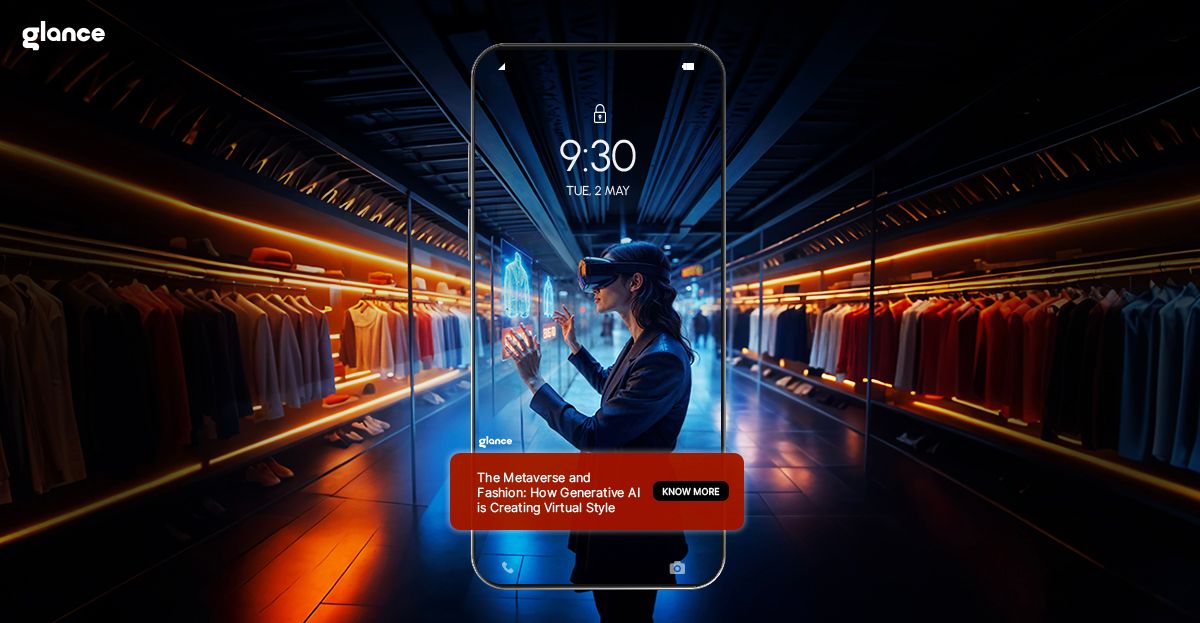Is an AI Style Advisor Better Than a Personal Stylist?
How to Use AI in Fashion: The Metaverse and Virtual Style


TL;DR:
The future of fashion lies at the intersection of creativity and code. From virtual catwalks to AI-generated outfits, knowing how to use AI in fashion unlocks limitless design, sustainability, and digital style personalization in the metaverse.
The Digital Revolution of Fashion: Where AI Meets the Metaverse
Fashion is no longer confined to fabric and form. In 2025, it’s pixels, algorithms, and immersive experiences. From AI-powered avatars wearing digital couture to virtual catwalks hosted inside the metaverse, fashion’s frontier has gone fully virtual.
Generative AI now drives this transformation—accelerating design, personalizing experiences, and redefining what “style” means in a borderless, digital-first world. According to Statista (2025), the global metaverse fashion market is expected to exceed US$507.8 billion by 2030, largely fueled by AI-led innovations.
What Is Virtual Fashion in the Metaverse?
Virtual fashion refers to clothing and accessories created for digital environments, including avatars in the metaverse or augmented reality (AR) try-on apps. These garments exist only in virtual spaces and allow users to dress their digital selves.
In metaverse fashion shows, viewers can attend via VR headsets or interactive platforms. NFTs, or non-fungible tokens, serve as proof of ownership for exclusive digital wearables. This creates a thriving ecosystem where fashion lives beyond fabric and form, representing identity in both social and gaming worlds.
How Generative AI Is Powering Virtual Style
AI-Driven Design Tools
Generative AI platforms like Midjourney, DALL·E, and Runway ML accelerate how to use AI in fashion design—turning prompts into full outfits instantly and reducing creative barriers.
Virtual Clothing Generation
AI can design garments that exist solely in digital space. From flowing fantasy gowns to futuristic streetwear, these clothes are worn by avatars or superimposed via AR. Brands and independent creators alike are tapping into this trend to offer digital exclusives.
Digital-only clothes—like fantasy gowns or holographic streetwear—are becoming more popular. According to Global Growth Insights, the digital fashion market was worth $1.1 billion in 2024 and is expected to grow to $7.7 billion by 2033, with a huge annual growth rate of 167%.
Avatar Personalization with AI
Learning how to use AI in fashion now includes personalizing digital wardrobes. AI styling tools use mood detection, facial recognition, and biometric data to create hyper-personalized avatars that reflect individual preferences and body proportions. It’s inclusivity redefined—digital fashion that fits everyone, everywhere.
AI and E-Commerce: Shopping in the Metaverse
- AI is transforming shopping into an intelligent experience. From personalized recommendations to virtual dressing rooms, consumers are now co-creating with algorithms. The global “AI in fashion” market is expected to soar from $2.2 billion in 2024 to $60.6 billion by 2034 (CAGR 39%).
- McKinsey adds that AI personalization can boost profits by up to $275 billion by 2028. In fact, studies show that organizations leveraging AI-driven personalization see nearly 2× higher engagement and 1.7× greater conversion rates across campaigns, underscoring why fashion retail is embracing generative styling tools.
Real-World Examples: Brands Redefining Digital Fashion
Brand | Virtual Fashion Initiative | Tech Used |
| Nike | Nikeland on Roblox | AR, AI |
| Gucci | Virtual Garden & NFTs | AI, AR |
| Balenciaga | Fortnite collab | 3D Design |
| DressX | Digital clothing for avatars | AI, NFT |
These collaborations show how knowing how to use AI in fashion can help brands connect to younger, digitally native audiences while reducing environmental footprint through virtual production.
Benefits of AI in Fashion & Metaverse
1. Sustainable Innovation
Learning how to use AI in fashion helps cut textile waste and emissions. Virtual prototypes eliminate the need for multiple physical samples, making the design process eco-friendly and cost-efficient.
2. Unlimited Creativity
In the metaverse, there are no limits to form or fabric. Designers can experiment with gravity-defying materials and holographic fabrics, pushing creativity beyond traditional craftsmanship.
3. Global Access to Style
AI-powered AR and VR apps democratize fashion, allowing anyone—anywhere—to try luxury digital outfits without production or shipping.
4. Data-Driven Personalization
AI uses real-time behavioral and biometric insights to tailor recommendations, offering truly personal fashion journeys across devices and platforms.
Challenges & Criticisms
The next era of fashion belongs to intelligence and imagination. Learning how to use AI in fashion helps both designers and consumers create smarter, more sustainable, and expressive styles. As AI reshapes how we visualize and wear clothes—physically or digitally—fashion becomes more inclusive, innovative, and intuitive.
Platforms like Glance prove that digital fashion isn’t futuristic anymore—it’s fashion’s new reality. The question isn’t whether AI will define style; it’s how quickly we’ll adapt to it.
How to Use AI in Fashion as a Creator or Consumer
For Designers
Designers can leverage AI tools to sketch, generate, and visualize garments instantly. Tools like CLO3D, Daz 3D, and Midjourney support virtual fittings and presentation. Participating in platforms like DressX lets designers monetize digital-only collections and gain visibility in virtual fashion weeks.
For Consumers
AI-driven shopping apps let users try on clothes using just a selfie or avatar. Platforms like Glance recommend digital outfits based on user behavior. Consumers can also use avatar creators to customize their virtual presence or attend digital fashion shows and social VR experiences.
The Future of Fashion: AI, Avatars & the Metaverse
The fashion industry is rapidly shifting toward AI-first, hyper-personalized digital wardrobes, where technology shapes every step of the styling process. From smart mirrors that recommend outfits in real time to biometric-based styling that suggests clothes based on your body data and preferences, AI is transforming how we dress—both physically and digitally.
Learning how to use AI in fashion is becoming essential for brands and consumers alike. Full virtual fashion lines—entire collections that exist only in the digital world—are gaining momentum as platforms integrate AI-driven design, avatar customization, and immersive shopping experiences.
According to a 2024 report by Market.us, the digital fashion market is projected to grow from $250 billion in 2024 to an astounding $1.7 trillion by 2034, with a compound annual growth rate (CAGR) of 21%. This explosive growth highlights the urgent need to understand how to use AI in fashion for trend forecasting, user personalization, and digital commerce.
Conclusion
The future of fashion is digital, and knowing how to use AI in fashion is key to staying relevant. From design to shopping, AI is reshaping how we create, wear, and experience style.
According to Precedence Research, the AI in fashion market is expected to grow from $2.2 billion in 2024 to over $60.6 billion by 2034, with a compound annual growth rate (CAGR) of 39%. Additionally, Market.us forecasts that the digital fashion market will skyrocket from $250 billion in 2024 to $1.7 trillion by 2034, highlighting the immense potential for those who know how to use AI in fashion to stay ahead of the curve.
Whether you're a designer aiming to launch digital-only collections or a consumer looking to personalize your avatar’s wardrobe, knowing how to use AI in fashion opens doors to limitless creativity, sustainable innovation, and global style accessibility. As technology and fashion converge, now is the perfect time to start exploring this digital frontier—because the next era of fashion is not just about what you wear, but how intelligently you create and experience it.
FAQs
Q1: How does AI create virtual fashion experiences in the metaverse?
AI designs digital garments, personalizes avatar styling, and powers AR/VR-based fashion shows that merge creativity with technology.
Q2: How is AI used in the metaverse?
AI in the metaverse powers immersive experiences by generating dynamic content, designing avatars, and predicting trends. It enables personalized interactions, adaptive virtual environments, and creative tools for fashion, gaming, and social engagement, making digital worlds more interactive and responsive to user behavior.
Q3: How does AI enhance virtual cultural fashion?
AI enhances virtual cultural fashion by curating designs that reflect regional heritage, local traditions, and global aesthetics. It analyzes user preferences, behavior, and emerging trends to create personalized, culturally relevant virtual outfits and experiences, making fashion in the digital space more inclusive, adaptive, and engaging.
Q4: What are metaverse platforms with AI design capabilities?
Metaverse platforms with AI design capabilities, like Glance, combine generative AI with digital environments to let users create, customize, and try virtual outfits. These platforms use AI to generate 3D assets, design immersive spaces, and provide interactive experiences, bridging fashion, gaming, and social interaction in the virtual world.
Q5: How is AI applied in virtual reality fashion?
AI powers intelligent environments, realistic garment simulations, and avatar interactions in VR-based fashion spaces.






